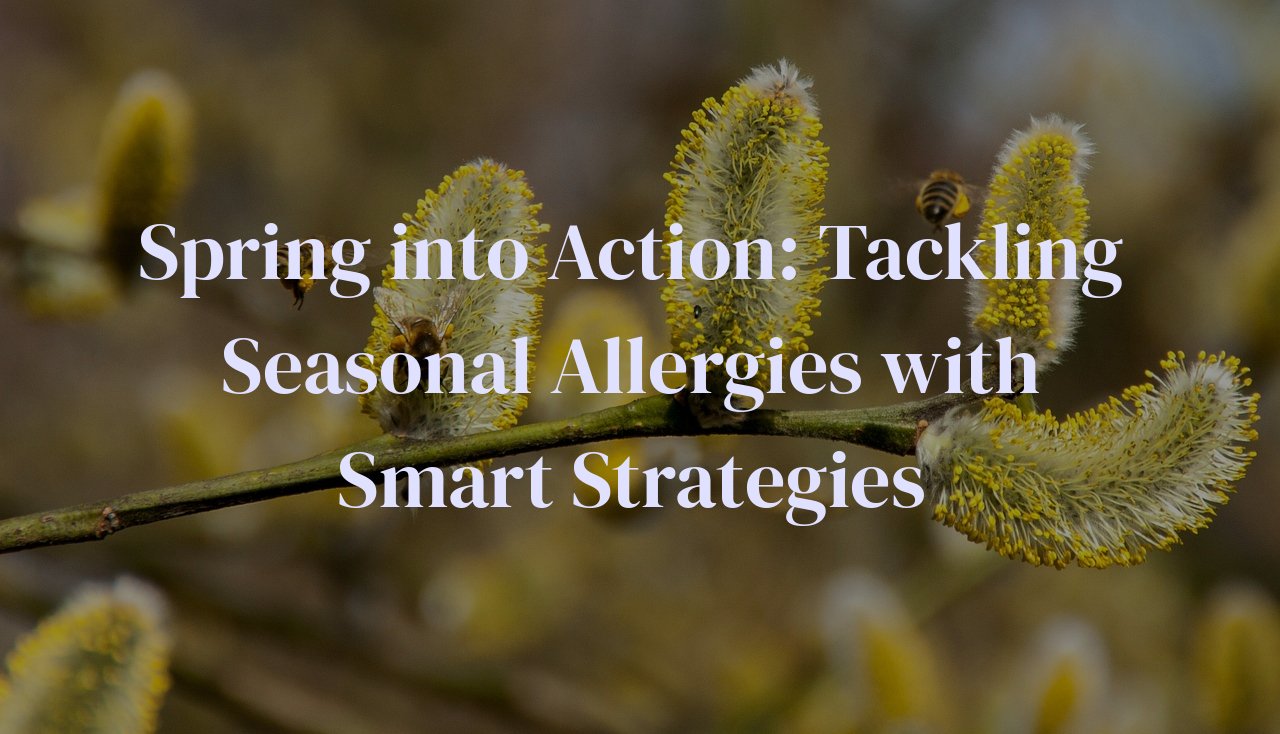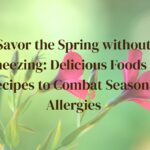
As the blossoms of spring fill the air with their sweet scent, a less welcome guest often arrives—seasonal allergies. This meticulously curated guide will delve into the diverse world of springtime allergic disorders, exploring their nuances and the effective coping mechanisms that can help you thrive during this vibrant season. By reading this post, you’ll learn about the various types of spring allergies, their triggers, and practical ways to manage them, allowing you to breathe easier and embrace the season’s beauty with renewed vigor and wellness.
Table of Contents
Understanding Spring Allergies: Identifying the Common Culprits
As someone who’s grappled with the sneezes and sniffles that arrive with the vernal equinox, I’ve come to know quite a bit about spring allergies. The blossoming of flowers and greening of trees are certainly sights to behold, but they bring with them an unseen swarm—the allergens.
The most notorious villain of this seasonal drama is pollen. Trees like oak, birch, and cedar start their reproductive dance, releasing vast plumes of pollen into the air. Grasses and weeds, too, join the fray, especially as the season progresses. Each tiny granule, a packet of potential life, has the uncanny ability to provoke our immune systems into overdrive.
But it’s not just the greenery that’s to blame. Mold spores, which thrive in damp, warming conditions, are also rife in spring. They float along, unseen, but for allergy sufferers, they are just as impactful as any pollen grain. The spring rain, while bringing relief to parched winter earth, also creates the perfect breeding ground for these spores.
Insects start to stir as well, and with them come dust mite populations, which can peak during spring. These tiny creatures, invisible to the eye, are prevalent in homes, feasting on shed human skin cells. It’s their waste products that are the actual allergens, causing a ruckus in indoor environments.
Finally, there is pet dander to consider, which may become more problematic in the spring as pets shed their winter coats and spend more time outdoors, inadvertently bringing in outdoor allergens.
Understanding these common culprits and how they each contribute to the symphony of springtime sniffles is key to finding relief. Recognizing the enemy is the first step in the battle against spring allergies, a battle I, like many, fight year after year.
Navigating Through Pollen Seas: Practical Avoidance Techniques
As a health enthusiast who has grappled with seasonal sniffles myself, navigating the turbulent seas of pollen is a topic I tackle with both personal passion and researched precision. Spring, for many, heralds not just the return of vibrant blooms, but also a wave of allergens that can wreak havoc on our daily lives. Here are my time-tested tactics for steering clear of those pesky pollen particles.
First and forthright, monitoring pollen counts becomes a ritual as essential as my morning cup of green tea. Websites and apps abound, providing real-time pollen levels. On days where these counts soar higher than my eagerness to embrace the warmer weather, I opt to stay indoors, especially during peak pollen hours which often fall between 5 AM and 10 AM.
Should I need to venture outdoors, gearing up is crucial. I don sunglasses that wrap around to shield my eyes, and I might even don a hat to prevent pollen from nesting in my hair. Upon returning home, a quick-change from my outdoor clothes and a shower to wash away any allergen hitchhikers is a non-negotiable ritual.
My windows, though calling out to be thrown open to let in the spring breeze, remain steadfastly closed to block out pollen’s entry into my sanctuary. Instead, I rely on air purifiers with HEPA filters, my silent guardians, keeping my indoor air as pristine as a mountain retreat.
Vehicles, those cozy carriers we often forget as pollen vectors, get special treatment. Keeping windows rolled up when driving and regularly changing the cabin air filter to one specifically designed to trap allergens keeps my commutes clear of sneeze triggers.
Last, but not least, my dearest furry companions, though ignorant of the agony they sometimes bring with their pollen-laden fur, receive more frequent baths in the spring. This routine, though sometimes met with disgruntled meows, ensures that our snuggles remain a comfort, not an itch to scratch.
With these measures, I navigate the pollen-laden springs, still able to rejoice in the season’s renewal and warmth. These strategies, woven into the fabric of my everyday life, allow not just survival, but thriving amid the floral flourish that so often comes with a hidden sneeze.
Nutritional Defense: Eating Smart to Combat Allergies
When spring breezes caress the blooms, and the world awakens in a kaleidoscope of colors, many of us find ourselves besieged by itchy eyes and relentless sneezes. This visceral dance with spring allergies had me explore the bounties of nature’s pantry, leading to the discovery that food can indeed play a pivotal role in managing allergic responses. Here’s how I harnessed the secret power of certain foods:
Quercetin-rich foods: This flavonoid functions as a natural antihistamine and an anti-inflammatory. Apples have become my snack of choice, not just because ‘an apple a day’ but because they’re laden with quercetin. Onions, too, which I generously incorporate into salads and sauces, add that extra quercetin boost which appears to stabilize mast cells, keeping histamines at bay.
Omega-3 powerhouses: Not all fats are foes, as I’ve learned while battling sniffles. Omega-3 fatty acids, found abundantly in flaxseeds, chia seeds, and fish like salmon and mackerel, have shown potent anti-inflammatory properties. Integrating these into my diet seemed to tone down the severity of my allergy symptoms, making spring less of an ordeal.
Probiotic-rich fare: As someone who once viewed my gut as merely a digestive organ, I’ve been enlightened to its role in immune function. Foods like yogurt and kefir, brimming with probiotics, appear to foster gut bacteria that could improve the immune response, possibly reducing allergic reactions. I make it a ritual now to include these in my breakfast bowl.
Vitamin C-packed treasures: Beyond its fame for warding off colds, Vitamin C’s antihistamine effect has won my favour. Citrus fruits like oranges and grapefruits not only perk up my palate but also seem to curb the springtime sniffles.
Incorporating these foods into my diet did not just become part of my routine; it became a form of self-care that allowed me to connect with my body’s needs and nature’s offerings on a plate. Remember, a diet change isn’t a cure, but a valuable tactic in our arsenal when matching wits with spring allergies. It’s an ongoing journey, where patience and consistency are as essential as the foods themselves.
Medicinal Allies: Over-The-Counter and Prescription Solutions
Spring heralds vibrant blooms and warmer weather, but for many of us, it also ushers in the annual bout with seasonal allergies. As a long-time sufferer and health blogger, I’ve learned that effectively tackling these allergies requires a well-stocked arsenal of medicinal allies. The journey towards relief often starts at the pharmacy aisle with over-the-counter (OTC) options like antihistamines. Antihistamines like cetirizine, loratadine, and fexofenadine are staples in my toolkit, helping to dial down the body’s allergic response to pollen and other allergens.
Decongestants are another OTC hero I turn to when I need relief from nasal congestion—one of the more aggravating symptoms. Pseudoephedrine and phenylephrine can be obtained readily, but it’s essential to use them judiciously as they can increase blood pressure. I always remind my readers to consult with their healthcare provider before adding decongestants to their regimen, especially if they have underlying health conditions.
When OTC options are insufficient, prescription solutions come into play. I’ve had seasons where my allergies were unyielding, and a visit to the allergist led to more potent interventions. Corticosteroid nasal sprays such as fluticasone and mometasone reduce inflammation in nasal passages, and I often share with my audience how these sprays provide significant relief when used consistently as part of a daily routine.
For those with severe allergies, immunotherapy may be suggested by a healthcare professional. Allergy shots or sublingual tablets can over time reduce sensitivity to allergens, an experience I found both fascinating and life-changing. It’s a longer-term commitment, but for those tired of the annual battle, it is an option worth exploring.
In conclusion, spring allergies can be managed effectively with the right combination of OTC medications, prescription treatments, and lifestyle adjustments. I encourage anyone struggling with seasonal allergies to not suffer in silence—there are numerous solutions that can help reclaim the joy of spring.
Holistic Harmony: Natural Remedies to Soothe Your Symptoms
When embarking on a holistic journey to combat spring allergies, I’ve found that restoring balance to the body isn’t only about dealing with the symptoms – it’s about nurturing one’s overall well-being. As someone who has faced the sneeze-inducing wrath of spring firsthand, I’ve discovered a few natural remedies that can soothe the symptoms and offer relief without relying solely on pharmaceuticals.
Firstly, nettle leaf supplements have been my go-to. Known for their anti-inflammatory properties, these supplements can act as a natural antihistamine. What’s fantastic is that they may reduce the body’s production of histamine, which is what causes those notorious allergy symptoms. I typically start taking them a few weeks before spring is in full swing to prime my body for the pollen onslaught.
Then there’s the wonder of local honey. While the evidence is anecdotal, I’ve felt that taking a teaspoon of locally sourced honey daily can help the body adapt to the local allergens. It’s a little like introducing your system to the pollen in small, manageable ways. Plus, it’s a delightful addition to my morning tea or toast!
Quercetin-rich foods also take a front-row seat in my dietary defense strategy. This powerful antioxidant is found in onions, apples, and black tea, supporting the immune system and potentially preventing the release of histamines. Integrating these foods into my daily diet has been beneficial in keeping those allergy symptoms at bay.
Essential oils, particularly eucalyptus and peppermint, are a staple in my springtime wellness kit. Diffusing these oils helps cleanse the air of allergens and opens up the respiratory passages. A personal tip: dilute a few drops of these oils in a carrier oil and apply to the chest – it’s like a breath of fresh air amidst the high-pollen count days!
Lastly, acupuncture is one complementary practice that’s gained my trust over the years. It aims to restore energy balance within the body, and several sessions have offered me noticeable relief from nasal congestion and itchy eyes.
These remedies do not replace medical advice but serve as my personal repertoire for aligning with the season harmoniously. It’s about finding a balance and what works best for you. Nature, in all its wisdom, often holds the gentlest, yet profound solutions to what ails us, and facing spring allergies is no different. My experience has led me to believe in the supportive power of these natural allies.
Conclusion
As the sun sets on another invigorating spring day, we are reminded of the strength we derive from understanding and confronting our allergies head-on. The information provided here aims to arm you with the knowledge and strategies necessary to neutralize the impact of seasonal allergic ailments. May this guide serve as your ally, helping you to celebrate the rebirth of nature without the burden of allergies. With these tools in hand, you may find yourself not just enduring the spring but, indeed, reveling in its splendor.



